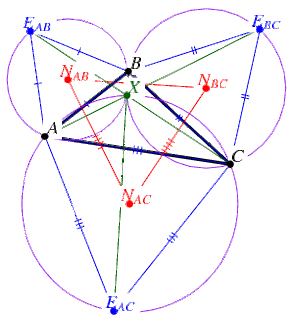Who is Pythagoras? What is this this theorem about? Pythagoras of Samos was a Greek philosopher who lived around 530 BC, mostly in the Greek colony of Crotona in southern Italy. According to tradition he was the first to prove the assertion (theorem) which today bears his name:
If a triangle has sides of length (a,b,c), with sides (a,b) enclosing an angle of 90 degrees ("right angle"), then
a2 + b2 = c2
A right angle can be defined here as the angle formed when two straight lines cross each other in such a way that all 4 angles produced are equal. The theorem also works the other way around and that is called the reciprocal of the Pythagorean theorem: if the lengths of the three sides (a,b,c) of a triangle satisfy the above relation, then the angle between sides a and b must be of 90 degrees.
Examples of both of the theorem
FIND LM:
In the triangle LNM right angled in N we have for after the Pythagorean theorem: 
LM² = LN² +NM²
LM2 =4² +3² =25
LM=√25=5
So we can conclude that that LM is equal to 5.
SHOW THAT THIS TRIANGLE IS RIGHT ANGLED:
 BC² =13²=169
BC² =13²=169
AB²+BC²=5²+12²=169
As BC2=AB2+BC2, for after the reciprocal of the Pythagorean theorem, the triangle ABC is right angled in A.
Proof of the Pythagorean theorem:
Bhaskara's first Proof of the Pythagorean Theorem:
Bhaskara was born in India. He was one of the most important Hindu mathematicians of the second century AD.
He used the following diagrams in proving the Pythagorean Theorem  In the above diagrams, the blue triangals are all congruent and the yellow squares are congruent. First we need to find the area of the big square two different ways. First let's find the area using the area formula for a square.
In the above diagrams, the blue triangals are all congruent and the yellow squares are congruent. First we need to find the area of the big square two different ways. First let's find the area using the area formula for a square.
Thus, A=c^2.
Now, lets find the area by finding the area of each of the components and then sum the areas.
Area of the blue triangles = 4(1/2)ab
Area of the yellow square = (b-a)^2
Area of the big square = 4(1/2)ab + (b-a)^2
= 2ab + b^2 - 2ab + a^2
= b^2 + a^2
Since, the square has the same area no matter how you find it
A = c^2 = a^2 + b^2.
By Vicnèche and Karan











